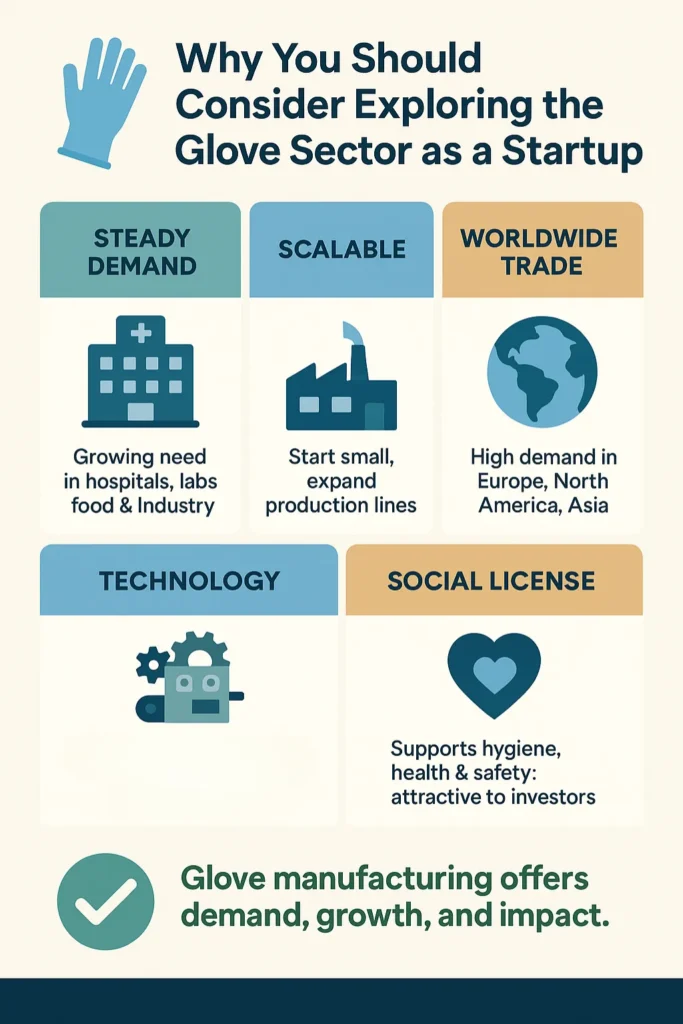By the year 2025, examination gloves had become more than just a medical device. They are now part of hygiene, safety, and infection control across the healthcare sector, laboratories, food processing, and multiple industries.
All over the world, the focus was more than ever on health. And, at the same time the requirement for health care and industrial safety grew enormously. This resulted in a big demand for latex and nitrile gloves.
We will discuss, in detail, why this industry is important, what it takes to start. what the market looks like, how to manufacture gloves, and what the government will provide. Everything you need to know before you become involved in this exciting industry.
Read Our Book: Click Here
Reasons to Start This Industry
The examination glove industry is one of the rare situations where you can have both social impact and profit.
Increasing Awareness of Global Health: Hospitals, clinics, labs, and even homes need gloves to protect from infection and contamination.
Regulatory Requirements: Gloves are becoming a requirement of the healthcare and industrial sector;you now have a captive market.
Pandemic Fatigue: The COVID-19 Pandemic demonstrated in a positive way the importance of PPE, and the demand for disposable gloves has remained high.
Diverse usage sectors: You can have success selling gloves within the health care, food processing, janitorial, lab, and industrial sectors; thereby offering a very vast market.
High profits: This sector sells its product at extremely high margins hardly taking into account low raw material costs.
Availability of Raw Material and Infrastructure (Site & Other considerations)
The success of glove manufacturing is contingent upon the availability of raw materials and the infrastructure to be able to manufacture:
Latex/natural rubber: Manufacturer present Latex from rubber trees, it’s elastic, comfortable, and price point driven.
Nitrile/synthetic rubber: Nitrile is more durable, has an excellent chemical resistance, and hypoallergenic, and is becoming more common than latex.
Supporting materials: All of the chemicals used during the vulcanization process, and all the powder or polymer coatings (on the gloves, or on the packaging) are all readily available globally.
Labor & Technical Knowledge: There are/does exist a growth of skilled technicians, engineers, and labor workers, there are/does exist a growth of technical colleges and institutes to obtain occupational skills in glove preparation and manufacturing.
Availability of raw materials or infrastructure should mean that glove manufacturing can be an attainable, and sustainable/investment opportunity.
Read Our Project Report: Click Here
Why you should consider exploring this sector as a startup.

There are multiple reasons why this is a sector to further explore:
Steady Established Demand: There is steady and increasing demand for gloves from hospitals, labs, food processing facilities and industry.
Scalable: You can start with a few production lines, and then scale to meet demand.
Worldwide Trade: There IS a demand for gloves in the world marketplace, and specifically in Europe, North America and Asia for good gloves.
Technology: The option of automated manufacturing processes, quality measuring machines, and the ability to procure higher quality raw materials, provide opportunities for productivity and quality.
Social License: Making a positive impact to hygiene, health related and safety has a social license appeal that makes it attractive to investors.
Projected Market Demand for the Future
The overall expansion of the global medical glove market has been incredibly strong and will remain so going forward the foreseeable future.
Health awareness, industrial safety requirements, and ongoing global health emergencies have hastened demand overall. More specifically, nitrile glove demand greatly accelerated as nitrile gloves also offer excellent protection against chemicals, and are considered latex-free, which many severe allergies exist. Industry sources include the following estimates:
The market size might be surpassing USD 4.5 billion in 2024 and grow to USD 13.5 billion by 2034, with a CAGR of ~11%.
Nitrile gloves might be making up nearly 50% of the overall glove market in 2024, while continuing to grow quickly.
Latex gloves to remain strong and grow consistently as healthcare-related applications grow.
Read More: Production of Latex & Nitrile Gloves
Manufacturing Process: Step-by-Step Process
The process for producing gloves out of latex and nitrile are generally the same but vary based on the final characteristics of the material. Below is a thorough description of the two processes to explain both materials:
1. Preparation of Raw Material
Latex Gloves: Now, let me explain how latex gloves are made. The source of latex is the rubber tree. Workers tap the rubber tree to collect the latex and then they clean it by filtering it to remove dirt and other particles. They add ammonia or other chemicals that are safe for gloves to keep it fresh and to stop it from clumping up.
Read More: Vinyl, Nitrile and Latex Disposable Medical Gloves Manufacturing
Nitrile Gloves: Now, let’s quickly discuss nitrile gloves. Nitrile is a synthetic rubber called nitrile butadiene rubber (or NBR). Workers mix NBR with certain chemicals, stabilizers and colors to make the material smooth and to keep it at a ready state to be processed into gloves.
Glove Dipping and Product Quality Chec: Before dipping and making the gloves, workers monitor the liquid material for thickness, pH, and smoothness, ensuring each glove maintains integrity and remains a comparable thickness.
2. Creating the Glove Shape
The materials used to dip into the glove are prepared for the gloves. The molds used to dip are made from ceramic or metal and are hand-shaped. They go through a rigorous cleaned first before dipping.
They may also go through a non-water-based coagulant solution (calcium nitrate or calcium carbonate) to facilitate a more even coat on the latex or nitrile material.
The molds are dipped into the latex or nitrile chemicals to create the glove shape.
Latex Gloves: The molds must be dipped multiple times in the latex material until adequate thickness is reached.
Nitrile Gloves: The dipping is carefully controlled for air bubbles, which could weaken the gloves and chemical resistance of the gloves.
Read More: Production of Surgical and Examination Latex Rubber Gloves
3. Vulcanizing / Curing
Once the immersion has completed, the gloves are moved to the ovens to vulcanize the rubber.
Reasons to Vulcanize:
1. Improve Elasticity and tensile strength
2. Increases puncture and tear resistance
3. Stabilizes the rubber for long term use
Throughout the process timing and temperature are controlled because under-cured gloves would be weak and over-cured would create brittle gloves.
4. Leaching & Washing
The gloves undergo leaching or washing by placing them in hot water or chemical solutions. Leaching or washing removes:
- Residues of proteins to help reduce the risk of latex allergic reactions.
Residual chemicals from coagulation or vulcanization. - Most medical-grade gloves will go through multiple leaching processes to ensure that the final product is biocompatible.
5. Drying
The gloves will be dried using either hot air ovens or tunnel dryers. It is essential that gloves all dry at the same time, and uneven remaining moisture can lead to weak, defective, or torn gloves at a later stage. For powder-free gloves, additional processing is performed to remove any surface powder and to further smooth the surface of the gloves to assist with donning.
6. Stripping / Pulling from Molds
The gloves will be stripped from the molds either manually or machine-assisted. Automated stripping machines will increase efficiency and systematically reduce the chance for tearing. During this stage, gloves are inspected for obvious defects such as holes, tears, or deformities.
7. Finishing
There may be additional finishing processes in the glove manufacturing process:
Chlorination – reduces tackiness and facilitates wearing.
Polymer Coating – A coating of polymer on powder-free gloves intended to assist with wearing.
Beading – Rolled cuffs designed to strengthen the wrist area.
Additives may be blended to produce color or texture.
8. Quality Control & Testing
Each batch of gloves undergoes thorough quality tests, including:
Visual Inspection – To see if there is surface defect, tear or uneven thickness.
Physical Testing included:
- An Air Inflation Test – The gloves are inflated with air and inspected for possible leaks
- Chemical Resistance Testing – Nitrile gloves must be subjected to oil and solvents to ensure long-term usage
- Powder Content and Biocompatibility – To ensure latex gloves meet testing requirement according to the application in medical use.
9. Packaging
Counting and Sorting Gloves: The gloves are manually sorted and counted.
Packing the Gloves: Depending on the purpose, gloves may be placed in clean or unclean boxes. Usually, machines pack the gloves in cases of bulk orders.
Maintaining Hygiene: This step minimizes the risk of germ contamination on the gloves and offers additional protection during packing.
Labeling: Employees attach one label on each package indicating the batch number and expiration date, which simplifies the organization of the gloves.
Important Information Regarding Production Efficiency
Modern companies will utilize a fully automated dipping line and/or facility to allow for high volume production.
Facilities will constantly monitor the following parameters: temperature, viscosity, and pH, to allow for traceability of quality control for their products.
Minimizing waste, recycling defective gloves, and using energy efficient curing ovens all can reduce operational costs.
Government Support (Brief Overview)
Governments are seeking to assist those manufacturing personal protective equipment such as gloves, on a world wide scale:
Subsidies & Grants: Often provided for machinery, a technology upgrade, and facility set-up.
Export Incentives: Assistance for less developed nations to up-sell PPE items, which include gloves.
Regulatory Standards: Guidelines to work within and follow in a clear manner such as: ISO 9001, ISO 13485, CE, and FDA; providing safety of products and ensuring the same expectations in the marketplace through documented process.
Infrastructure Support: Investments into logistics, port systems, and industrial zones to ensure a timely and effective process flow; supporting exact processes for all PPE processes.
The above constitutes a great landscape for different types of glove manufacturers and stakeholders.
How NPCS (or Consultancy Services) Can Help
Launching an Examination Gloves (Latex & Nitrile) Manufacturing business requires significant preparation and planning; as a result, consultancies like NPCS (Niir Project Consultancy Services) can be invaluable.
NPCS works with individuals and companies to provide comprehensive support services from preparing in-depth project reports that describe costs, equipment, space, personnel, and revenue to developing a comprehensive business plan tailored to your budget and market characteristics.
Find the Best Idea for Yourself With our Startup Selector Tool
Conclusion
The examination glove sector, which includes both nitrile and latex gloves, will be among the largest, fastest-growing, most profitable, and socially responsible industries of 2025.
Globally, the market is expanding, socio-economic conditions are improving, raw materials are abundant, government support is available for entrepreneurs, and the potential for scaling-up opportunities is immense.
With a growing emphasis on quality, conformity to regulations, and compliance with standards, there is a potential small company to make a profitable business and contribution to improving hygiene and health and safety around the world.
Frequently Asked Questions (FAQs)
What is the difference between latex gloves and nitrile gloves?
Latex gloves are natural, flexible, and comfortable to wear, but may induce an allergy. Nitrile gloves are synthetic, chemical resistant, and hypoallergenic which make them very useful.
Can a smaller manufacturer step into the glove business?
Yes, with good equipment, good quality practices, and good strategy in place, it is possible for small startups to become successful in the glove industry.
What qualification/fast-track certification does a company need for export?
ISO 13485, a CE marking for Europe, and FDA approval for the USA are normative certifications that need to be in place.
Are nitrile gloves price-competitive with latex gloves more than anything else?
Most of the time, yes. However, you will definitely receive more value from chemical resistance and the health aspect of both nitrile and latex, being hypoallergenic gloves.
How is quality managed in the manufacturing process?
Standardized processes, testing puncture and tensile strength of the gloves, and providing quality management independently and in every stage of production.







